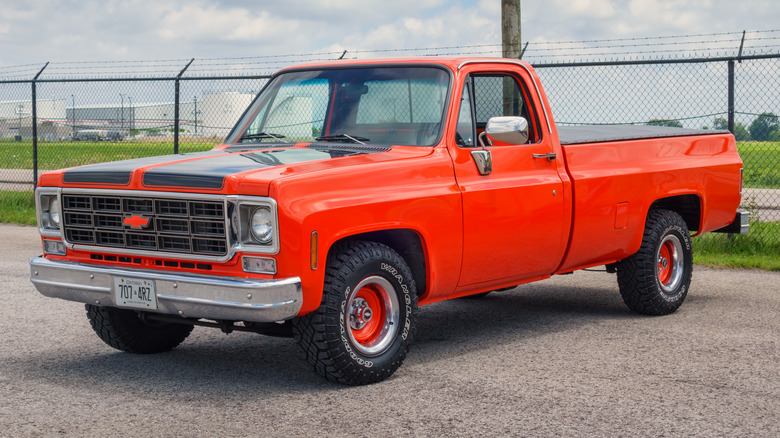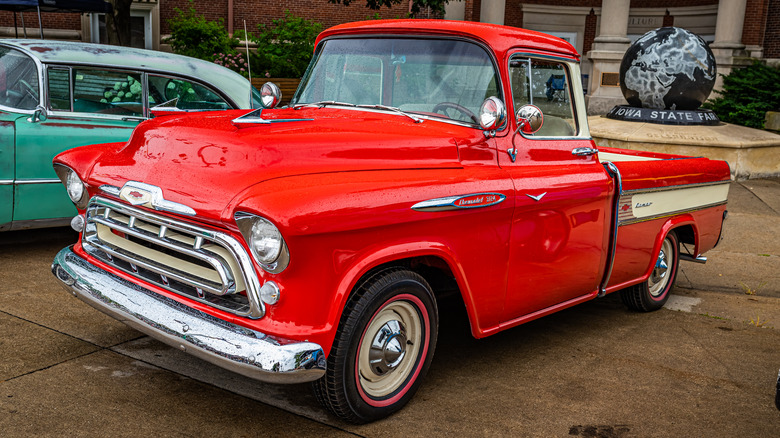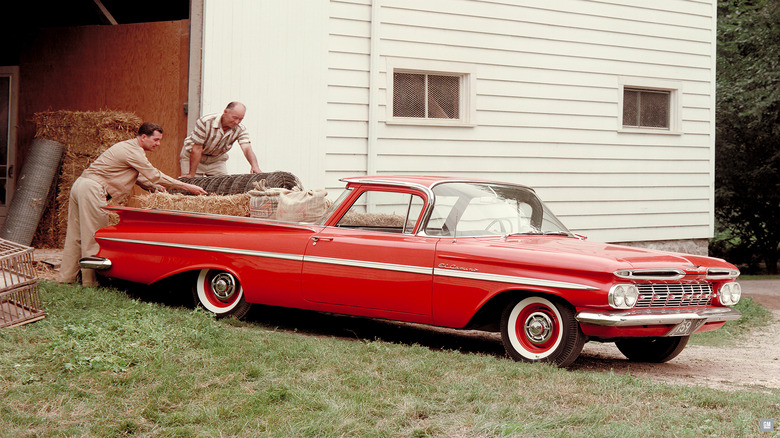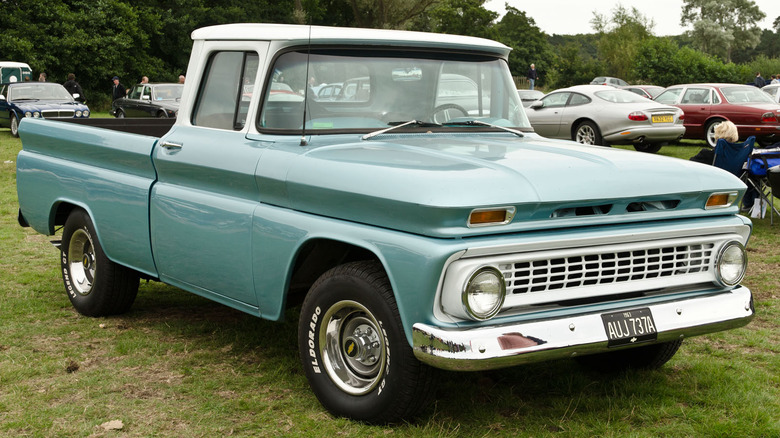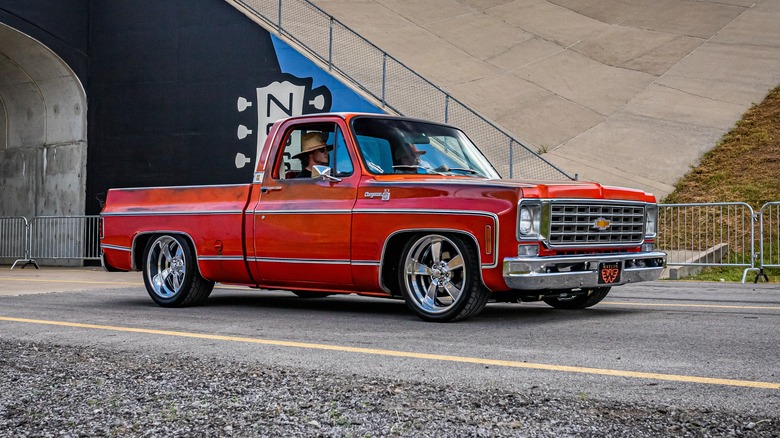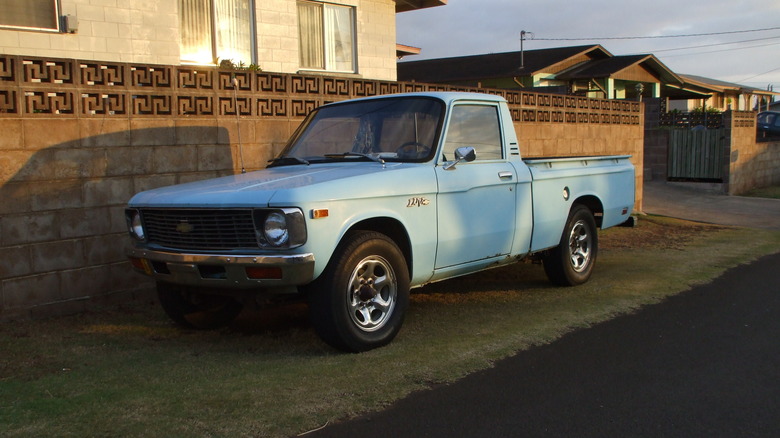5 Classic Chevrolet Trucks To Consider For Your Next Project
When William Durant and Louis Chevrolet founded Chevy in 1911, there were more than 270 automobile companies in the United States, but the only four that remain today are Chevrolet, Buick, Cadillac, and Ford. In its more than a century in business, Chevy has produced eight generations of the iconic Corvette along with muscle car legends like the Chevelle and Camaro, which debuted in 1967. It's not hard to find parts for vintage Chevys, including those two high-powered cars.
Chevy also cranked out some highly desirable pickup trucks in its long history. These models are also attractive project candidates due to high original production numbers, relative affordability, and robust support in terms of technical advice, replacement parts, and upgrades for intake and fuel delivery, exhaust, and electrical systems. With all that in mind, here are a few of the most attractive project Chevrolets that are better suited for hauling cargo than burning up a dragstrip.
1955-58 Cameo Carrier
There are two big reasons to take on a restoration or restomod project: to make a profit from your original investment, and/or to end up with a stunning classic vehicle to drive or show. The Chevrolet Cameo Carrier pickup can deliver on both fronts. The Cameo was part of the Task Force series, which debuted in 1955 and added some of the signature styling of the era to a formerly utilitarian segment. The Cameo Carrier was simply a Task Force truck with fiberglass panels affixed to the bed sides and tailgate. The red-and-white color scheme was similar to that of early Corvette models; this was no coincidence, as the Cameo's fiberglass shell was made by Moulded FIberglass in Ashtaboula, Ohio. That company was also responsible for building the bodies for the first Corvettes.
The 1955 Cameo Carrier was only available in red and white, but eight colors were available for the 1956 model year, and several more were added for 1957. For the Cameo's last model year in 1958, the front end was reconfigured to house four headlights, making that vintage easy to spot. Just a little more than 10,000 were produced over that four-year run, which makes the Cameo hard to find but valuable once restored. We found seven currently for sale, with prices ranging from just under $40,000 to almost $100,000. Fully restored Cameo Carriers go for an average of over $60,000, though, with three going for $125,000-plus in the past three years.
El Camino
Late in 1958, Chevy began selling the 1959 El Camino, a low-slung utility coupe/pickup mashup modeled after the popular Ford Ranchero and Australian 'utes' that came before. The El Camino was crafted using an Impala-inspired body and the underpinnings of the Biscayne Brookwood station wagon. It was not initially a hot seller, and Chevy dropped the model temporarily after making just over 36,000 units in its first two years. The El Camino was back in 1964 on a new platform shared with the Chevelle , and engine options grew steadily over that second generation. A Super Sport version came with the third generation in 1968, and for 1970 the El Camino SS could be purchased with Chevy's 454 cubic inch LS6 V8 that produced 450 horsepower and 500 pound-feet of torque.
New emissions regulations then reined the El Camino in along with the rest of the domestic car lineup, and by the late '70s the 454's power output had been cut by more than half. The El Camino hung around through 1987, with the latest edition getting V6s and diesel engines as options. Picking up a fifth generation El Camino (1978-87) gives you the best chance to make a sizable profit. These models can often be had for just a few thousand dollars and flipped for $30,000 or more once completely restored.
[Featured image by Chevrolet via Wikimedia Commons | Cropped and scaled | Public Domain]
1960-66 C/K series
For the 1960 model year, Chevy introduced the C/K series of pickups as a replacement for the Task Force trucks. Models beginning with a C were two-wheel drive, and K trucks had four-wheel drive. Chevy kept these labels in place until 1987, when it switched to using V for two-wheel drive and R for four-wheel drive trucks. The number that came after the C or K indicated the truck's weight class: 10 for half-ton, 20 for three-quarter ton, and 30 for one ton. 1960 C and K series trucks had a torsion bar independent suspension instead of a rigid front axle, the first time Chevy used this configuration. For the 1963 model shown above, Chevy went to a more advanced A-arm system with coil springs and updated the base straight-six engine offerings to a 140 horsepower 3.8 liter and 165 horsepower 4.8 liter.
Through 1965, the biggest engine option was a 283 cubic inch V8, but for 1966 buyers could opt for a 327-inch engine that produced 220 horsepower. The C/K series got a major update in 1967, including new engine and transmission options. 1960-66 C and K trucks are readily available for well under $10,000 and can be enhanced with LS series engine swaps or more modest upgrades like fuel injection systems and HEI distributors. For those of you interested in a faithful restoration, OEM Chevy parts are still available for these trucks.
[Featured image by SG2012 via Wikimedia Commons | Cropped and scaled | CC-By 2.0]
1973-1986 C/K series
The third generation of C/K series trucks that appeared for the 1973 model year also make excellent project candidates. This generation saw a boxier body design that give it the unofficial "Square Body" moniker. Along with the new body, the second generation saw the introduction of power locks and windows in 1977 and a diesel engine option the following year.
Second-generation C/K trucks ran through 1986, after which the line was given the aforementioned R/V designations. As with the first generation, these trucks can easily be found for just a few thousand dollars and sold for well above the $50,000 mark when fully restored or customized. Two C10s sold in January of 2023 for more than $200,000: a 1983 custom lowrider went for $228,250, and a 1973 Custom sold just a couple weeks later for an even $220,000. Those were extreme examples, though; the average sale price of the nearly 1,300 third-gen C/K trucks that have sold in the past five years sits at just under $26,000.
LUV
As American customers warmed to smaller and more fuel-efficient vehicles throughout the 1960s, pickup truck offerings from the domestic Big Three remained stubbornly large and gas thirsty. In March of 1972, General Motors got the jump on Ford and Chrysler by importing the Isuzu Faster compact pickup and selling it as the "LUV" (light-utility vehicle). At the time, GM owned more than a third of Isuzu, which made the process easy. Chevy sold more than 60,000 LUVs between its introduction and the end of 1973, prompting Ford to rebadge the Mazda B1600 as the Ford Courier and Dodge to later bring Mitsubishi trucks to the U.S. as the Dodge D50 and Plymouth Arrow.
Increases in power and the addition of an optional long-wheelbase version had LUV sales cresting the 71,000 mark by 1978, and the addition of four-wheel drive the following year brought a Motor Trend Truck of the Year Award and sales of more than 100,000 trucks. Lackluster performance and the introduction of the S10 led to the demise of the LUV after 1982, but by then Chevy had sold a half-million of the little stalwarts.
Despite that number, LUVs are relatively hard to find these days. We could only locate one current listing, a 1981 model with an asking price of $12,000. The 26 reported sales in the past five years have been for between $6,278 and $46,000, with an average price of just over $14,000.
[Featured image by 293.xx.xxx.xx via Wikimedia Commons | Cropped and scaled | Public Domain]
